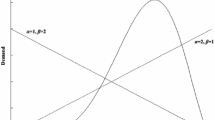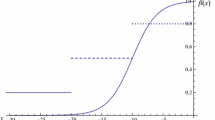Abstract
In today's time-based competition, the unit cost of a high-tech product declines significantly over its short life cycle while its demand increases. In this paper, we extend the classical economic order quantity model to allow for not only time-varying demand but also fluctuating unit cost. In addition, we also allow for shortages and partial backlogging. We then prove that the optimal replenishment schedule not only exists but also is unique. In addition, we also show that the total cost is a convex function of the number of replenishments, which simplifies the search for the optimal number of replenishments to find a local minimum. Moreover, we further simplify the search process by providing an intuitively good starting search point.

Similar content being viewed by others
References
Lee HL, Padmanabhan V, Taylor TA and Whang S (2000). Price protection in the personal computer industry. Mngt Sci 46(4): 467–482.
Heizer J and Render B (2000). Operations Management, 6th edn. Prentice-Hall: NJ.
Resh M, Friedman M and Barbosa LC (1976). On a general solution of the deterministic lot size problem with time-proportional demand. Opns Res 24: 718–725.
Donaldson WA (1977). Inventory replenishment policy for a linear trend in demand: an analytical solution. Opl Res Q 28: 663–670.
Barbosa LC and Friedman M (1978). Deterministic inventory lot size models-a general root law. Mngt Sci 24: 819–826.
Henery RJ (1979). Inventory replenishment policy for increasing demand. J Opl Res Soc 30(7): 611–617.
Dave U (1989). A deterministic lot-size inventory model with shortages and a linear trend in demand. Naval Res Logis 36: 507–514.
Goyal SK, Morin D and Nebebe F (1992). The finite horizon trended inventory replenishment problem with shortages. J Opl Res Soc 43(12): 1173–1178.
Teng JT, Chern MS and Yang HL (1997). An optimal recursive method for various inventory replenishment models with increasing demand and shortages. Naval Res Logist 44: 791–806.
Hariga MA and Goyal SK (1995). An alternative procedure for determining the optimal policy for an inventory item having linear trend in demand. J Opl Res Soc 46(4): 521–527.
Teng JT (1996). A deterministic replenishment model with linear trend in demand. Opns Res Lett 19: 33–41.
Dave U and Patel LK (1981). (T, Si) policy inventory model for deteriorating items with time proportional demand. J Opl Res Soc 32(1): 137–142.
Sachan RS (1984). On (T, Si) policy inventory model for deteriorating items with time proportional demand. J Opl Res Soc 35(11): 1013–1019.
Hariga MA (1996). Optimal EOQ models for deteriorating items with time-varying demand. J Opl Res Soc 47: 1228–1246.
Yang HL, Teng JT and Chern MS (2001). Deterministic inventory lot-size models under inflation with shortages and deterioration for fluctuating demand. Naval Res Logist 48: 144–158.
Goyal SK and Giri BC (2001). Recent trends in modeling of deteriorating inventory. Eur J Opl Res 134: 1–16.
Chang HJ and Dye CY (1999). An EOQ model for deteriorating items with time varying demand and partial backlogging. J Opl Res Soc 50: 1176–1182.
Papachristos S and Skouri K (2000). An optimal replenishment policy for deteriorating items with time-varying demand and partial–exponential type–backlogging. Opns Res Lett 27: 175–184.
Teng JT, Chang HJ, Dye CY and Hung CH (2002). An optimal replenishment policy for deteriorating items with time-varying demand and partial backlogging. Opns Res Let 30: 387–393.
Teng JT, Yang HL and Ouyang LY (2003). On an EOQ Model for Deteriorating Items with Time-Varying Demand and Partial Backlogging. J Opl Res Soc 54(4): 432–436.
Teng JT, Chern MS, Yang HL and Wang YJ (1999). Deterministic lot-size inventory models with shortages and deterioration for fluctuating demand. Opns Res Lett 24: 65–72.
Bellman RE (1957). Dynamic Programming. Princeton University Press: Princeton, NJ.
Friedman MF (1982). Inventory lot-size models with general time-dependent demand and carrying cost function. INFOR 20: 157–167.
Acknowledgements
The authors would like to thank Professor Maw-Sheng Chern at National Tsing-Hua University in Taiwan for his constructive comments. This research was partially supported by the National Science Council of the Republic of China under Grant NSC-92-2213-E-007-065, and a two-month research grant in 2003 by the Graduate Institute of Management Sciences in Tamkang University in Taiwan. In addition, the principal author's research was supported by the ART for Research and a Summer Research Funding from the William Paterson University of New Jersey.
Author information
Authors and Affiliations
Corresponding author
Appendices
Appendix A. Proof of Lemma 1
Let

We then have

If c v′(t)⩾C′(t)>0, then we know from (A2) that ∂TC i /∂t i ⩾0. Therefore, for any given i, TC i is increasing with t i . This implies that TC i (s i−1, t i , s i )⩾TC i (s i−1, s i−1, s i ) for any fixed i. Consequently, we obtain

This completes the proof of (a).
Next, if  (t
i) ⩽ −
(t
i) ⩽ −  (t,t
i
) < 0, with t⩽t
i
, then we know from (A2) that ∂TC
i
/∂t
i
⩽0. Thus, for any given i, TC
i
is decreasing with t
i
. This implies TC
i
(s
i−1, t
i
, s
i
)⩾TC
i
(s
i−1, s
i
, s
i
), for any i. Therefore, we know
(t,t
i
) < 0, with t⩽t
i
, then we know from (A2) that ∂TC
i
/∂t
i
⩽0. Thus, for any given i, TC
i
is decreasing with t
i
. This implies TC
i
(s
i−1, t
i
, s
i
)⩾TC
i
(s
i−1, s
i
, s
i
), for any i. Therefore, we know

which proves part (b).
Appendix B. Proof of Lemma 2
From (11), we know that the optimal value of s i (ie, s i *) is the interior point between t i and t i+1 because if s i =t i or t i+1, then Equation (11) does not hold. TC(n, {s i }, {t i }) is a continuous (and differentiable) function minimized over the compact set [0, H]2n. Hence, there exists an absolute minimum. The optimal value of t i (ie, t i *) cannot be on the boundary since TC(n, {s i }, {t i }) increases when any one of the t i 's is shifted to the end points 0 or H. Consequently, there exists at least an inner optimal solution satisfied (11) and (12). Since s 0=0 and t 1 * is unique, if we can prove that both s i * generated by (12) and t i+1 * by (11) are uniquely determined, then we prove Lemma 2.
For any given s i and t i , from (11), we set

If C′(t)>c v′(t)>−S t (s i , t) for all t, then we have

By the mean value theorem, we get

for some t i ⩽k i ⩽s i . By taking the first derivative of F(x) with respect to x, we obtain

Consequently, there exists a unique t i+1 (>s i ) such that F(t i+1)=0, which implies that solution to Equation (11) uniquely exists. Similarly, from (12), we set

Likewise, if C′(t)>c v′(t)>−S t (s i , t) for all t⩾s i , then we have

Taking the first derivative of G(x) with respect to x, we obtain

As a result, we know that there exists a unique s i (>t i ) such that G(s i )=0. Thus, the solution to Equation (12) uniquely exists. Therefore, we complete the proof of Lemma 2.
Appendix C. Proof of Theorem 1
For any fixed n, differentiating TC(n, {s i }, {t i }) with respect to t 1 and simplifying terms, we obtain

If we relax s n to be any number, then we know from (11) and (12) that

which implies that TC(n, {s i }, {t i }) without the boundary condition of s n =H is an increasing function of t 1. From (11) and (12), we know that if t 1=0 (or H), then s n (t 1)=0 (or >H). As a result, for any given n, there exists a unique t 1 such that TC(n, {s i }, {t i }) in (10) is minimized with s n =H. This proves (a).
To prove (b), we know from (11) that the optimal value of s i (ie, s i *) is the interior point between t i and t i+1 because if s i =t i or t i+1, then Equation (11) does not hold. TC(n, {s i },{t i }) is a continuous (and differentiable) function minimized over the compact set [0, H]2n. Hence, there exists an absolute minimum. The optimal value of t i (ie, t i *} cannot be on the boundary since TC(n, {s i },{t i }) increases when any one of the t i s is shifted to the end points 0 or H. Consequently, (11) and (12) are the necessary and sufficient conditions for the absolute minimum.
Appendix D. Proof of Theorem 2
Let us set

where R(n)=nc f and T(n,0,H) = ∑ i = 1 n (P i + c h I i + c b B i + c l L i ) − nc f . Firstly, we know that R(n) is an increasing convex function of n. Next, by Bellman's principle of optimality,22 we know that the minimum value of T(n, 0, H) is

Let t=H and hence T *(n, 0, H) < T *(n−1, 0, H). The strict inequality follows because the minimum in (D2) occurs at an interior point. Thus, T *(n, 0, H) is strictly decreasing in n. Recursive application of (D2) yields the following relations:


In order to prove that T *(n, 0, H) is strictly convex in n, we choose H 1 and H 2 such that

and

Employing the principle of optimality on (D5) again, we have

and

respectively. Since H is an optimal interior point in T *(n+1, 0, H 1) and T *(n+2, 0, H 2), we know that

and

Utilizing the fact that

and

where w is the replenishment time between (a, b), and both a and b are the time at which the inventory level drops to zero in the cycle (a, b). We then obtain

where t n *(n, 0, H) and t n+1 *(n+1, 0, H 1) are the corresponding last replenishment time when n orders are placed in [0, H], and n+1 orders are placed in [0, H 1], respectively.
Similarly,

Subtracting (D12) from (D13), we have

since k(t)=[(c h/θ)+c v(t)]eθ(H−t) is a decreasing function for all t<H. This implies that T *(n, 0, H)−T *(n+1, 0, H) is a strictly increasing function of H. Thus,

Again, by (D2) and the principle of optimality, we have

Let t=H in (D16), we have


which implies T *(n, 0, H) is convex in n, and hence, TC(n)=R(n)+T *(n, 0, H) is also convex in n.
Rights and permissions
About this article
Cite this article
Teng, JT., Yang, HL. Deterministic economic order quantity models with partial backlogging when demand and cost are fluctuating with time. J Oper Res Soc 55, 495–503 (2004). https://doi.org/10.1057/palgrave.jors.2601678
Received:
Accepted:
Published:
Issue Date:
DOI: https://doi.org/10.1057/palgrave.jors.2601678




